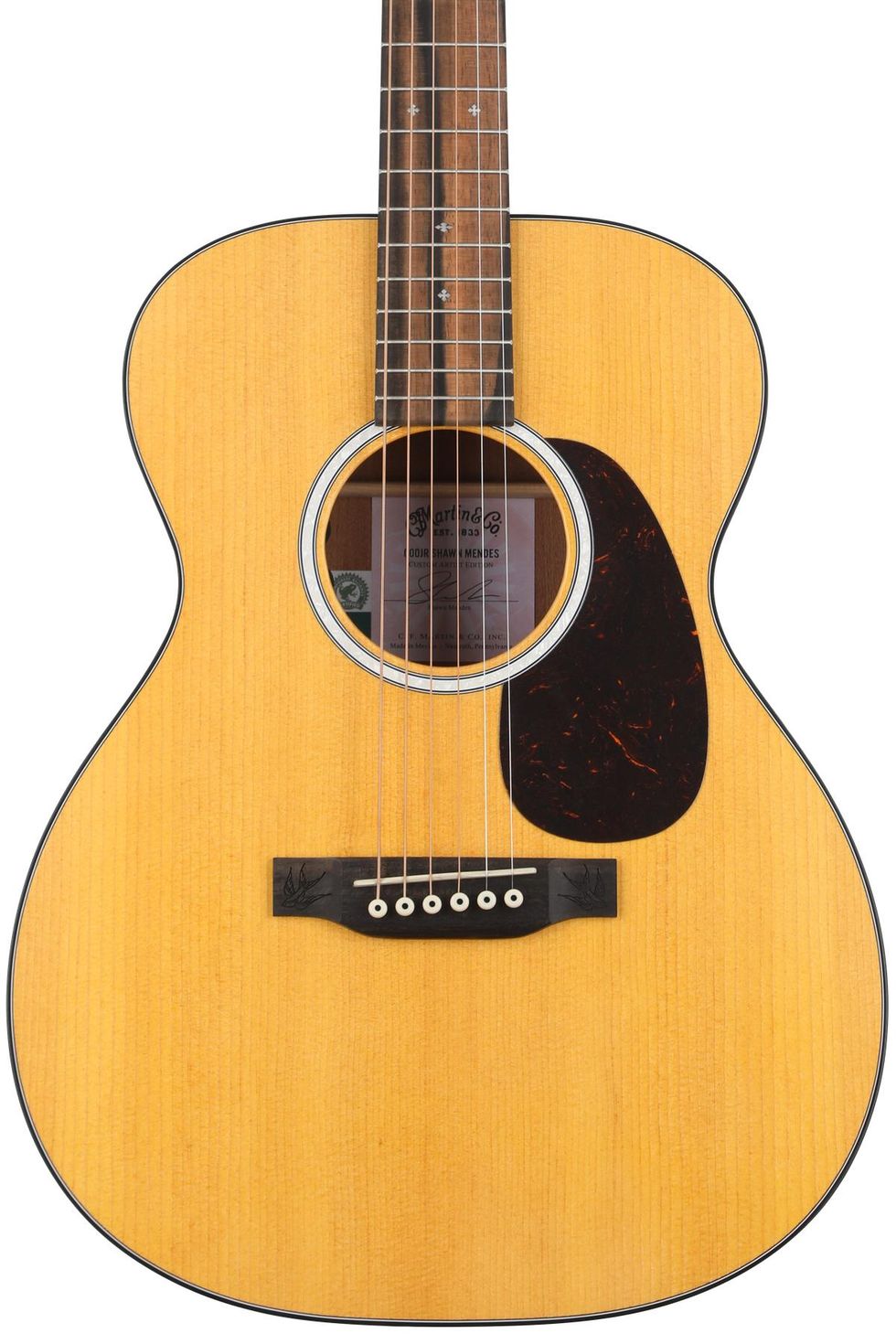There’s not a lot of reason for Martin to mess with new body styles. Just about every standard shape in their line—from the 0, 00, 000, up through their dreadnoughts—are inarguably stone-cold classics and foundational works from which much of the rest of the acoustic-guitar industry takes their inspiration and cues.
The release of the $799, Mexico-made 000JR-10E Shawn Mendes, however, turns a spotlight on a Martin body style that, to date, could qualify as underappreciated. It also finds the company toying with construction based completely on Forest Stewardship Council (FSC)-rated sustainable tonewoods and, in turn, addressing the reality of shrinking and endangered traditional tonewood supplies that faces the whole guitar industry. The results of this effort are a comfortable, affordable, high-quality, and inviting flattop that says a lot about where the industry can still go in terms of design and materials.
A Body in Between
If you don’t play a lot of different acoustic guitars, you could conceivably pick up the Mendes (which is based on the existing standard 000JR-10) and notice little more than the fact that it’s smaller than a dreadnought and bigger than a parlor guitar. If you’ve got a little more experience with the breadth of acoustic body shapes and neck sizes out there, though, you’ll notice that the Mendes is indeed a unique and unusual amalgam of design elements.
“Junior” designation aside, Martin’s decision to call the Mendes and its 000JR-10 and 000JR-10E stablemates “000s” is a curious one. The Mendes is actually closest in dimensions to a 00, though the body is shorter and the profile is a bit more pinched at the waist than on that venerable Martin shape. The neck, too, may feel unusual to a seasoned acoustic player. It’s built around a short 24" scale, where most Martins are a 24.9" or 25.4" scale. The short scale feels even more unique for the presence of the 000JR-10E’s most 000-like element, a 1 3/4" nut width.
Combined with the relatively substantial neck profile, the wider nut width makes the Mendes feel very easy to play.
Together, the Mendes’ most vital dimensions and design elements add up to an interesting whole. It’s small enough to feel a little like an instrument from the larger “travel” guitar category populated by guitars like Taylor’s GS Mini. But few guitars in that loose categorization feature a neck as expansive feeling as that on the Mendes, which benefits immensely from the wider nut width. Combined with the relatively substantial neck profile, the wider nut width makes the Mendes feel very easy to play. The wider spacing facilitates alternate thumb picking, while the shorter scale makes extended chords easier. For players used to classic formulas, the mix could feel strange. For less biased players and many novice players who aren’t attuned to such nuances, the blend could be ideal.
Construction quality, by the way, is excellent. The woods used here are all FSC certified, right down to the bracing—which means they are sourced from responsibly managed forests. But they will be familiar tonewoods to Martin enthusiasts and acoustic players in general. The back and sides are layered sapele, while the top is Sitka spruce. The grain on the latter is rather plain, but the top is no less lovely for it, and an informal tap test reveals it to be a very resonant, lively section of lumber. The 2-piece neck is made from sipo, an African hardwood quite like mahogany. The fretboard, meanwhile, is surprisingly made from ebony. Responsible sourcing of the ebony on the fretboard means that the wood used here isn’t the uniform, ultra-dark type you see on top-shelf acoustics. But the grain variation is lovely and works well with the Mendes-specific design touches like the signature at the third fret and diamond-pattern, mother-of-pearl inlay. Inside and out, fit and finish are perfect. And we can’t say that about every $800 flattop we see.
Easy Equilibrium
Like most small-body guitars, the Mendes won’t bowl you over with low end. But the projection from the 000JR body is still impressive. You hear very, very little of the messy, compressed, blur you typically hear from guitars of this size when you strum vigorously. In fact, the guitar feels very punchy and exceptionally balanced across the whole frequency spectrum when you hit it hard.
That balance is just as evident in fingerstyle situations. The first and second strings ring with a particularly sweet and crystalline clarity that chimes beautifully against the round, concise resonance of the third and fourth strings. And again, while the low end won’t dislodge any pictures from the wall, the output from lower strings creates a very cohesive and rich, if compact, harmonic whole.
The Verdict
While there aren’t a ton of structural details to differentiate the Shawn Mendes signature edition from its less expensive 000JR-10 and 000JR-10E stablemates, the little differences add up to an interesting guitar. The honey-hued finish on the top and the inlay both add an upmarket aura to the instrument. And construction from 100 percent FSC tonewoods is no small or inconsequential distinction. We love to see guitar companies follow this path and execute the instruments made with these woods with such care. Materials and ethics aside, however, it’s cool to see this signature release shine a light on a Martin model family that, to this point, may have received less than its due respect. Like the 000JR-10 and 000JR-10E, it’s an exceptionally comfortable and sweetly ringing instrument that fits many styles.
Martin 000JR-10E Shawn Mendes Demo | First Look
Martin 000JR-10E Shawn Mendes Signature Acoustic-electric Guitar
- Shawn Mendes signature embellished with swallow design that recalls his hand tattoo symbolizing home as a place filled with family, friends, and loved ones
- Spruce top and sapele back and sides offer strong, bright fundamentals with balanced tone
- Scaled-down Auditorium body shape sits easily in the hands of any player

















